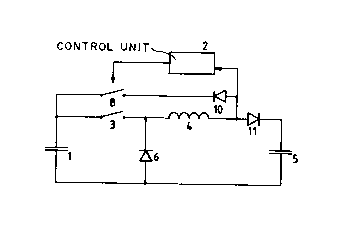Some of the information on this Web page has been provided by external sources. The Government of Canada is not responsible for the accuracy, reliability or currency of the information supplied by external sources. Users wishing to rely upon this information should consult directly with the source of the information. Content provided by external sources is not subject to official languages, privacy and accessibility requirements.
Any discrepancies in the text and image of the Claims and Abstract are due to differing posting times. Text of the Claims and Abstract are posted:
| (12) Patent: | (11) CA 2052031 |
|---|---|
| (54) English Title: | CHARGING CIRCUIT FOR RADAR TRANSMITTER |
| (54) French Title: | CIRCUIT DE CHARGE POUR EMETTEUR RADAR |
| Status: | Expired and beyond the Period of Reversal |
| (51) International Patent Classification (IPC): |
|
|---|---|
| (72) Inventors : |
|
| (73) Owners : |
|
| (71) Applicants : | |
| (74) Agent: | SMART & BIGGAR LP |
| (74) Associate agent: | |
| (45) Issued: | 1999-03-16 |
| (22) Filed Date: | 1991-09-23 |
| (41) Open to Public Inspection: | 1992-04-05 |
| Examination requested: | 1996-07-09 |
| Availability of licence: | N/A |
| Dedicated to the Public: | N/A |
| (25) Language of filing: | English |
| Patent Cooperation Treaty (PCT): | No |
|---|
| (30) Application Priority Data: | ||||||
|---|---|---|---|---|---|---|
|
An improved resonant charging circuit is disclosed for the charging
of a pulse-forming network (5) from a voltage source (1), provided
with:
i) a first serial circuit provided with a switch (3), an
inductor (4), and a diode (11);
ii) a second serial circuit provided with a diode (6), the
inductor (4), a diode (10), and a switch (8);
iii) a control unit (2) for opening and closing the switches (3, 8).
Circuit de charge résonant amélioré permettant la charge d'une ligne à retard (5) depuis une source de tension (1), comprenant les éléments suivants : i) un premier circuit en série muni d'un commutateur (3), d'une bobine d'inductance (4) et d'une diode (11); ii) un deuxième circuit en série comprenant une diode (6), une bobine d'inductance (4), une diode (10) et un commutateur (8); iii) une unité de commande (2) pour ouvrir et fermer les commutateurs (3, 8).
Note: Claims are shown in the official language in which they were submitted.
Note: Descriptions are shown in the official language in which they were submitted.

2024-08-01:As part of the Next Generation Patents (NGP) transition, the Canadian Patents Database (CPD) now contains a more detailed Event History, which replicates the Event Log of our new back-office solution.
Please note that "Inactive:" events refers to events no longer in use in our new back-office solution.
For a clearer understanding of the status of the application/patent presented on this page, the site Disclaimer , as well as the definitions for Patent , Event History , Maintenance Fee and Payment History should be consulted.
| Description | Date |
|---|---|
| Inactive: IPC from MCD | 2006-03-11 |
| Time Limit for Reversal Expired | 2001-09-24 |
| Letter Sent | 2000-09-25 |
| Grant by Issuance | 1999-03-16 |
| Inactive: Final fee received | 1998-11-25 |
| Pre-grant | 1998-11-25 |
| Notice of Allowance is Issued | 1998-10-15 |
| Notice of Allowance is Issued | 1998-10-15 |
| Letter Sent | 1998-10-15 |
| Inactive: Application prosecuted on TS as of Log entry date | 1998-10-09 |
| Inactive: Status info is complete as of Log entry date | 1998-10-09 |
| Inactive: First IPC assigned | 1998-09-10 |
| Inactive: IPC removed | 1998-09-10 |
| Inactive: IPC assigned | 1998-09-10 |
| Inactive: Approved for allowance (AFA) | 1998-09-09 |
| Request for Examination Requirements Determined Compliant | 1996-07-09 |
| All Requirements for Examination Determined Compliant | 1996-07-09 |
| Application Published (Open to Public Inspection) | 1992-04-05 |
There is no abandonment history.
The last payment was received on
Note : If the full payment has not been received on or before the date indicated, a further fee may be required which may be one of the following
Please refer to the CIPO Patent Fees web page to see all current fee amounts.
| Fee Type | Anniversary Year | Due Date | Paid Date |
|---|---|---|---|
| MF (application, 6th anniv.) - standard | 06 | 1997-09-23 | 1997-06-26 |
| MF (application, 7th anniv.) - standard | 07 | 1998-09-23 | 1998-06-16 |
| Final fee - standard | 1998-11-25 | ||
| MF (patent, 8th anniv.) - standard | 1999-09-23 | 1999-06-22 | |
| MF (application, 2nd anniv.) - standard | 02 | 1993-09-23 |
Note: Records showing the ownership history in alphabetical order.
| Current Owners on Record |
|---|
| HOLLANDSE SIGNAALAPPARATEN B.V. |
| Past Owners on Record |
|---|
| ALBERT PIETER STEGEMAN |